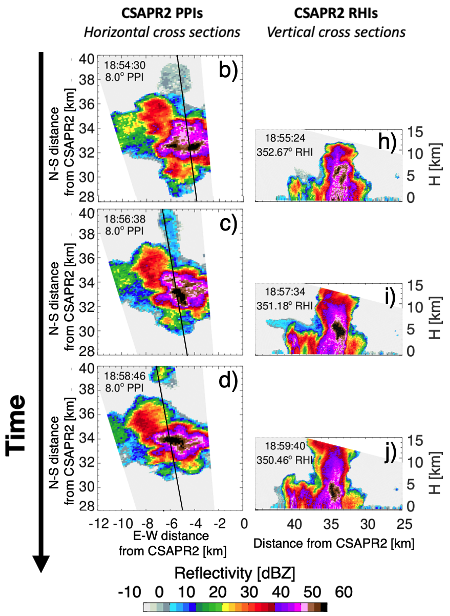How the CSAPR2 collected 20,000 vertical cross-sections through evolving convection during TRACER
Submitter
Lamer, Katia — Brookhaven National Laboratory
Kollias, Pavlos — Stony Brook University
Area of research
Cloud Processes
Journal Reference
Science
Deep convective cells are challenging to characterize since they tend to be short lived and since their properties are closely tied to the environment in which they form and evolve. To increase the likelihood of observing the vertical structure (with little to no gaps), spatial variability (at sub-km scale), and temporal evolution (at ~2-min resolution) of convective cells, we expanded the Multisensor Agile Adaptive Sampling (MAAS) smart-sensing framework and used it to guide the CSAPR2 and CHIVO tracking C-band radars during the TRACER and ESCAPE field campaigns.
Impact
Between 01 June and 30 September 2022 MAAS guided the CSAPR2 and CHIVO into sampling ~1,300 unique isolated cells over parts of their life cycle with most being sampled for at least 15 min at scan repetition times less than 2 min. Preliminary analysis reveals potential scientific benefits of this novel sampling strategy. The large amounts of radar scans (over 315,000 sector RHIs in 680 hrs) containing cloud/precipitation information (as opposed to clear air) that were collected using MAAS also clearly demonstrate the value of having near-real-time data transfer and communications among different instruments connected in a network.
Summary
Multisensor Agile Adaptive Sampling (MAAS), a smart-sensing framework, was adapted to increase the likelihood of observing the vertical structure (with little to no gaps), spatial variability (at sub-km scale), and temporal evolution (at ~2-min resolution) of convective cells. In this adaptation, MAAS automatically analyzes the latest NEXRAD data to identify, characterize, track, and nowcast the location of all convective cells forming in the Houston domain. MAAS then uses a list of predetermined rules or real-time user input to select a convective cell to be tracked and sampled by the CSAPR2 and CHIVO C-band radars via a combination of rapid sector PPI and RHI scans.
Between 01 June and 30 September 2022 over 315,000 vertical cross-section observations (i.e., RHIs) were collected by the C-band radars through ~1,300 unique isolated convective cells, most of which were observed for over 15 min of their life cycle at scan repetition times less than 2 min. To the best of our knowledge, this data set, collected primarily through automatic means, constitutes the largest data set of its kind.


